Dive deep into our comprehensive guide on kitchen and bathroom backsplashes. Discover the latest trends, material choices, installation tips, and maintenance for an aesthetic and functional enhancement of your home.
The Ultimate Guide to Kitchen and Bathroom Backsplashes
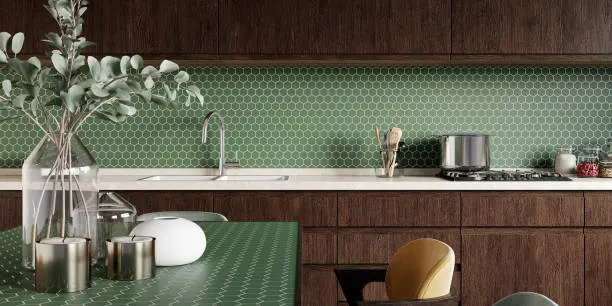
Backsplashes are vital components in the design and functionality of kitchens and bathrooms. This extensive guide offers insights into the selection, installation, and maintenance of the perfect backsplash, ensuring that it enhances both the aesthetics and practicality of your home.
What is a Backsplash?
A backsplash is an essential feature in modern kitchens and bathrooms, serving both a functional and aesthetic purpose. Primarily, it’s installed to protect the wall behind a sink or stove from splashes of water, grease, or other cooking residues. However, its role extends beyond protection, contributing significantly to the interior design and overall style of a room.
The Importance of Backsplashes
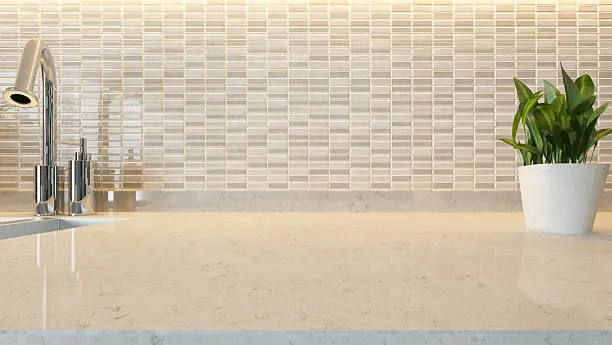
Backsplashes play a pivotal role far beyond their basic function of protecting kitchen and bathroom walls from spills and stains. They are integral to the overall design and ambiance of these spaces, significantly influencing both aesthetics and practicality.
- Aesthetic Influence: Backsplashes are not just functional elements; they contribute substantially to the visual appeal of your kitchen and bathroom. The choice of material, color, and pattern of the backsplash can set the tone for the room’s style. Whether it’s a bold, colorful pattern that makes a statement or a subtle, elegant design that complements the surroundings, backsplashes have the power to tie the room’s design elements together cohesively.
- Practical Functionality: The primary purpose of a backsplash is to protect wall surfaces from moisture, food splatters, and potential stains — common occurrences in kitchens and bathrooms. This protective feature helps in maintaining the integrity and cleanliness of walls, making them easier to clean and maintain over time.
- Enhancing Room Ambiance: The right backsplash can transform the feel of a kitchen or bathroom. For instance, a backsplash with reflective surfaces like glass can brighten a room and make it appear more spacious. Similarly, using natural stone can add an element of warmth and luxury.
- Design Versatility: The versatility of backsplashes in terms of materials — from classic ceramic tiles to contemporary glass or metal finishes — offers endless possibilities for personalization. This versatility means that there’s a backsplash option to suit any design theme, from traditional to modern minimalist.
Protection Against Water and Stains
Backsplashes serve a crucial role in safeguarding walls from water and stains in areas of your home that are most exposed to moisture and grease. This protective function is particularly vital in kitchens and bathrooms.
- In the Kitchen: Behind the sink and stove, walls are regularly exposed to splashes from washing dishes and cooking. A backsplash in these areas effectively shields the wall from water and grease. This barrier not only prevents unsightly stains but also protects the wall material from moisture-related damage, such as peeling paint or warping.
- In the Bathroom: Around the sink and sometimes in shower areas, backsplashes are key to preventing water damage. Water splashes, if not checked, can lead to mold growth and structural damage over time. A well-installed backsplash acts as a sealant, keeping the walls dry and maintaining the integrity of the bathroom.
- Material Durability: The materials typically used for backsplashes, like ceramic, glass, or metal, are chosen for their ability to withstand constant exposure to water and varying temperatures. These materials are not only resistant to moisture but are also easy to clean, ensuring that areas prone to grease and water splashes remain hygienic and well-maintained.
- Long-Term Wall Protection: By guarding against water seepage and stain accumulation, backsplashes play an essential role in prolonging the life of your walls. This protection is a cost-effective solution that maintains the structural and aesthetic integrity of the walls, reducing the need for frequent repairs and repainting.
Enhancing Design and Aesthetic Appeal

Backsplashes are crucial in defining the design and aesthetic of kitchens and bathrooms. They do more than protect walls; they significantly impact the space’s style and ambiance.
- Focal Point: A backsplash often becomes the centerpiece of a room, drawing attention and setting the design tone.
- Style Setter: The material and design of the backsplash can dictate the room’s style, from modern and sleek to traditional and rustic.
- Color and Texture: It offers an opportunity to introduce color and texture, adding depth and character to the room.
- Personalization: With a wide range of materials and designs, backsplashes allow for personal expression in home decor.
Ceramic and Porcelain Tiles
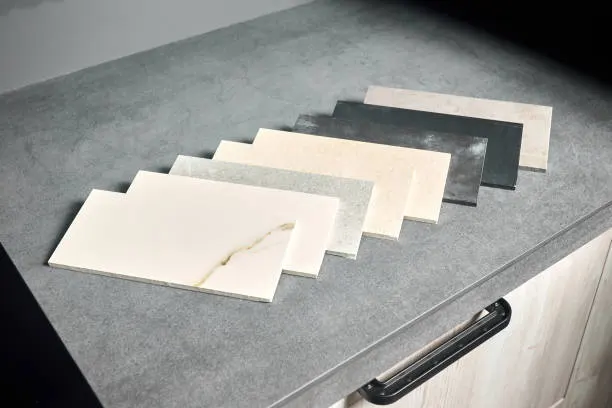
These are popular due to their versatility and durability. They offer a wide range of colors, patterns, and sizes, fitting various design preferences. Easy to clean and resistant to heat and moisture, they are ideal for busy kitchens and bathrooms.
Pros:
- Versatility in Design: With a vast array of colors, patterns, and sizes available, they can suit any design aesthetic, from traditional to modern.
- Durability: These tiles are known for their strength and longevity. They can withstand the wear and tear of high-traffic areas, making them a lasting choice.
- Easy Maintenance: Both ceramic and porcelain tiles are relatively easy to clean. Simple wiping can often remove any stains or spills, which is especially useful in areas prone to messes.
- Resistance to Heat and Moisture: They are highly resistant to heat and moisture, making them ideal for areas around stoves and sinks, as well as in bathrooms.
- Cost-Effective: Ceramic tiles, in particular, are often more affordable compared to other backsplash materials, offering a budget-friendly option without compromising on style.
Cons:
- Installation Complexity: Installing these tiles can be complex, often requiring professional help, especially for intricate designs or large areas.
- Grout Maintenance: The grout between tiles can become a breeding ground for mold and mildew if not properly maintained, especially in damp environments.
- Hardness: While their hardness contributes to durability, it also means that dropped items are more likely to break upon impact.
- Porcelain’s Higher Cost: Porcelain tiles tend to be more expensive than ceramic due to their denser and more durable nature.
- Cold Underfoot: These materials do not retain heat well, making them cold underfoot, which might be uncomfortable in some climates without underfloor heating.
Glass Tiles
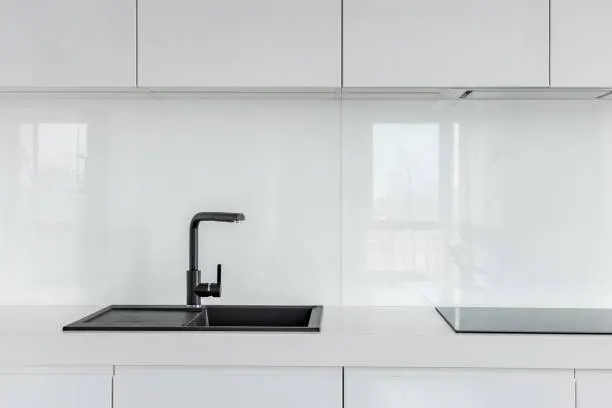
Glass tiles provide a modern and sophisticated look. They reflect light, adding brightness and the illusion of space. These tiles are also easy to maintain and are resistant to stains, making them a practical choice for high-maintenance areas.
Pros:
- Modern Aesthetic: Glass tiles offer a sleek and sophisticated look, instantly modernizing any space.
- Light Reflection: They excel in reflecting light, brightening the room and creating an illusion of increased space, which is particularly beneficial in smaller or darker areas.
- Low Maintenance: Glass tiles are relatively easy to clean and maintain. Being resistant to stains, they can be wiped down quickly, keeping the area looking pristine.
- Stain Resistance: Unlike porous materials, glass does not absorb stains, making it ideal for areas prone to spills and splatters.
- Color and Design Variety: Available in various colors and designs, glass tiles provide flexibility in creating a unique backsplash that matches your design vision.
Cons:
- Installation Sensitivity: Glass tiles can be more challenging to install than ceramic or porcelain. They require careful handling and precise cutting, often necessitating professional installation.
- Cost: They can be more expensive compared to other tile materials, potentially impacting your budget for renovations.
- Scratch Visibility: While resistant to stains, glass tiles can show scratches more easily, which might be a concern in high-traffic areas.
- Fragility During Installation: Glass tiles are more fragile than ceramic or porcelain, making them susceptible to breakage during transport and installation.
- Limited Heat Resistance: Unlike ceramic or porcelain, glass tiles might not be the best choice directly behind high-heat areas like stoves without proper backing, as they can crack under extreme temperature changes.
Natural Stone
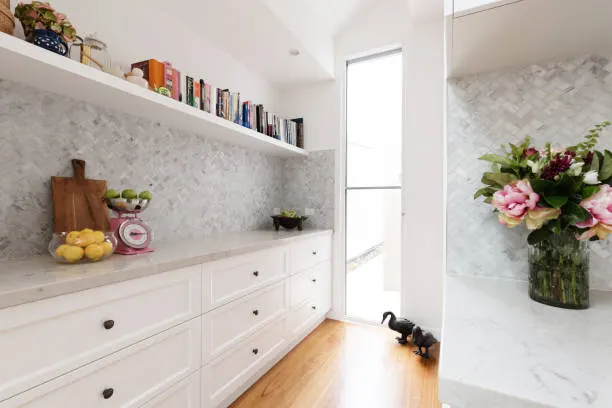
Natural stone tiles like granite, marble, or slate add a touch of luxury and uniqueness, as no two tiles are exactly the same. However, they are generally more expensive and require regular sealing to prevent stains.
Pros
- Unique Aesthetic: Each natural stone tile is unique, offering unparalleled beauty and a luxurious feel. The variations in color and pattern contribute to a rich, upscale look.
- Durability: Natural stone is known for its longevity and resilience. Properly maintained, these tiles can last for decades, making them a long-term investment for your home.
- Adds Value: Natural stone can increase the value of your property due to its premium look and durability.
- Natural Look: For those seeking an organic, earthy aesthetic in their home, natural stone is an excellent choice. It can blend seamlessly with various interior designs, from rustic to modern.
Cons
- Higher Cost: Natural stone tiles are generally more expensive than other types of tiles like ceramic or porcelain, both in terms of material and installation.
- Maintenance Requirements: They require regular maintenance, including sealing to prevent stains and damage. This ongoing care can be more intensive compared to other tile options.
- Porosity: Some natural stones are porous and can absorb spills, leading to staining if not sealed properly.
- Weight: Natural stone tiles are heavy, which can be a challenge in terms of transportation and installation, and may not be suitable for all types of substrates.
- Variation in Tiles: While the uniqueness of each tile is a pro, it can also be a con. The variations in color and pattern might not always align with the homeowner’s expectations or may make it challenging to replace damaged tiles with an exact match.
Metal and Stainless Steel
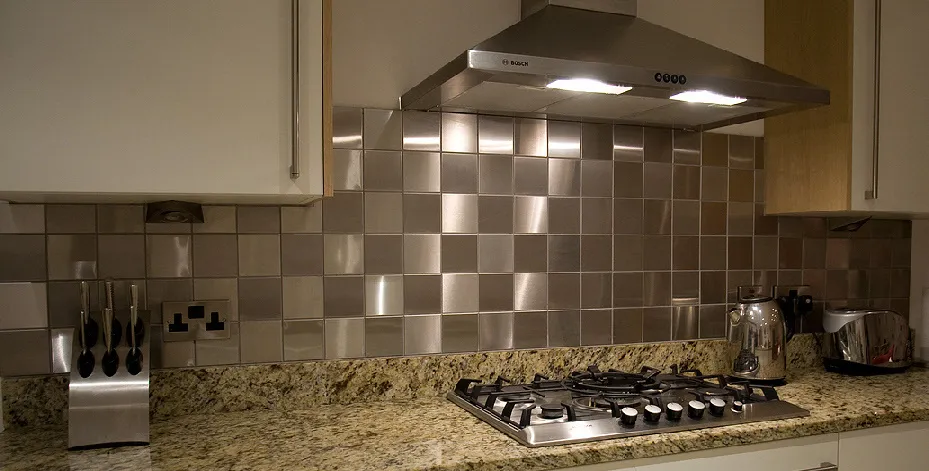
For those seeking a contemporary or industrial look, metal or stainless steel backsplashes are excellent options. They are durable and resistant to heat, although they can be prone to scratches.
Pros:
- Modern Aesthetic: Metal and stainless steel backsplashes offer a contemporary and industrial look, ideal for modern kitchen designs.
- Durability: These materials are known for their strength and longevity, holding up well against daily wear and tear.
- Heat Resistance: Both metal and stainless steel are highly resistant to heat, making them suitable for use behind stoves and other high-temperature areas.
- Hygienic and Easy to Clean: Stainless steel, in particular, is non-porous and doesn’t harbor bacteria, making it a hygienic choice. It’s also easy to clean and maintain.
- Reflective Quality: The reflective surface of these materials can brighten up a space and give an illusion of a larger area.
Cons:
- Prone to Scratches: Metal surfaces can be susceptible to scratches and dents, which may become more noticeable over time.
- Water Spots and Fingerprints: Stainless steel can show water spots and fingerprints, requiring frequent cleaning to maintain a pristine appearance.
- Cost: High-quality metal and stainless steel backsplashes can be on the higher end of the price spectrum compared to other materials.
- Cold Feel: The metallic surface can give a colder, more utilitarian feel to a space, which might not align with every design preference.
- Installation Considerations: Cutting and fitting metal or stainless steel can be challenging, often requiring professional installation.
Alternative Materials
Exploring unconventional materials like cork, wood, or thermofoil can set your space apart. These materials offer unique textures and colors but may require more meticulous care and maintenance.
Pros:
- Unique Aesthetic: These materials provide unique textures and colors, offering a distinct look that can make your space stand out.
- Customization: With options like cork, wood, or thermofoil, there’s a vast potential for customization in terms of design, pattern, and finish, allowing for a truly personalized kitchen or bathroom space.
- Warmth and Texture: Materials like wood and cork add warmth and natural texture to a space, creating a welcoming and cozy ambiance.
- Innovative Designs: Thermofoil and other synthetic materials come in a wide range of contemporary designs and can mimic the look of more expensive materials at a lower cost.
Cons:
- Maintenance and Durability: These materials often require more meticulous care and maintenance. For instance, wood can be susceptible to moisture damage and may require regular sealing or treatment.
- Moisture Sensitivity: Materials like cork and wood are more sensitive to moisture compared to traditional tile or stone, making them less ideal in very wet environments unless properly treated and sealed.
- Heat Resistance: Alternative materials may not offer the same level of heat resistance as traditional backsplash materials like ceramic or glass, which is a consideration if installing near stoves or heat sources.
- Longevity Concerns: Depending on the quality and installation, these materials might not have the same longevity as more conventional backsplash options, potentially leading to earlier replacement or repair needs.
- Style Specificity: While unique, these materials might not suit every design style and could potentially limit future redesign options or affect resale value.
Design Trends and Personalization
Keeping up with the latest design trends is essential for ensuring your backsplash is not only functional but also aligns with contemporary styles. Here’s how current trends and personalization play a crucial role in backsplash choices:
- Current Trends: Design trends in backsplashes often reflect broader movements in interior design. Current preferences might include minimalist patterns, bold statement tiles, or eco-friendly materials. Staying informed about these trends can help in selecting a backsplash that’s both modern and stylish.
- Personalization: A backsplash is an excellent opportunity to express personal style in your kitchen or bathroom. Whether it’s through the choice of material, color, or pattern, it can serve as a reflection of your personality and design preferences.
- Functionality and Style: The best backsplash choices balance functionality with aesthetic appeal. This means selecting materials and designs that not only look good but also suit the practical needs of your space, whether it’s easy cleaning, durability, or moisture resistance.
- Adapting Trends to Personal Taste: While it’s great to be trend-aware, it’s also important to adapt these trends to fit your personal taste and the overall design of your home. This ensures your backsplash complements your space and doesn’t feel out of place.
- Longevity in Design: When considering trends, it’s wise to think about longevity. Some trends are timeless and will look great for years to come, while others might quickly date your space. Choosing a design that you’ll be happy with in the long term is key.
Current Color and Pattern Trends in Backsplash Design
Backsplash design trends continuously evolve, showcasing a range of styles from bold and dramatic to minimalist and understated. Understanding these trends can help in selecting a backsplash that not only reflects current tastes but also complements your personal style.
- Bold and Dramatic Colors: A trend toward vibrant and dynamic colors in backsplash tiles has emerged. These bold choices can make a striking statement in a kitchen or bathroom and are often used to add a focal point or contrast to a neutral palette.
- Minimalist Styles: On the other end of the spectrum, minimalist styles remain popular. These often involve muted colors and simple designs that create a clean, uncluttered look. This style is particularly suited to modern and Scandinavian-inspired interiors.
- Geometric Patterns: Geometric patterns are a significant trend, offering a contemporary twist on traditional designs. These patterns range from simple shapes to more complex arrangements, adding visual interest and texture to a space.
- Herringbone Layouts: The herringbone pattern has seen a resurgence, providing an elegant and timeless look. This classic layout can be used with various tile types, adding sophistication to both modern and traditional kitchens and bathrooms.
- Classic Subway Tiles: The enduring appeal of subway tiles continues. Their simple, rectangular shape offers versatility, working well in almost any design scheme. While traditionally seen in white, subway tiles are now available in various colors and finishes, allowing for more creativity.
- Mix and Match Trends: Current trends also lean towards mixing and matching different colors, patterns, and textures. This approach allows for a high degree of personalization, enabling homeowners to create a unique backsplash that reflects their taste and complements their home’s aesthetic.
Custom Mosaic and Artistic Tiles
Custom mosaic and hand-painted tiles offer a unique and personalized approach to backsplash design. They are perfect for those looking to create a standout feature in their kitchen or bathroom.
- Bespoke Artistry: Custom mosaic tiles allow for artistic expression in your space. They can be arranged in specific patterns or designs that reflect personal tastes or artistic visions. This can range from intricate geometric patterns to pictorial designs or abstract arrangements.
- Hand-Painted Elegance: Hand-painted tiles provide an opportunity for one-of-a-kind artistic expression. These tiles often feature detailed artwork and can range from traditional motifs to contemporary designs. Each tile becomes a piece of art, contributing to a backsplash that is as much a focal point as it is functional.
- Personalization: Both custom mosaics and hand-painted tiles offer a high degree of personalization. They can be tailored to fit specific color schemes, themes, or design ideas, ensuring that your backsplash reflects your unique style and complements the overall aesthetic of your kitchen or bathroom.
- Visual Impact: These artistic backsplash options can transform an ordinary space into an extraordinary one. They add color, texture, and visual interest, making the backsplash a central feature of the room.
- Craftsmanship and Quality: Custom and hand-painted tiles often showcase exceptional craftsmanship. This attention to detail not only adds to the aesthetic appeal but also ensures a quality product that can stand the test of time.
Installation and Maintenance: Ensuring Longevity
Ensuring the longevity and pristine appearance of your backsplash hinges on two key aspects: proper installation and diligent maintenance. Both play a vital role in preserving the functionality and aesthetic appeal of your backsplash over time.
DIY vs. Professional Installation
The decision between DIY and professional installation of a backsplash should be based on the complexity of the design and the type of material being used.
- DIY Installations: For those with some home improvement experience, DIY installation can be a cost-effective solution for simpler backsplash designs. It allows for a personalized touch and can be quite satisfying for the hands-on homeowner. Materials like basic ceramic or peel-and-stick tiles are more suited for DIY due to their ease of handling and installation.
- Professional Installation: More complex materials, such as natural stone, glass, or intricate tile patterns, often require the expertise of a professional. Professional installers can ensure that these more delicate materials are handled correctly and installed with precision. This not only guarantees a high-quality finish but also ensures that the backsplash will be durable and long-lasting.
Cleaning and Maintenance
Different backsplash materials will have varying maintenance needs, which are crucial to keep in mind for preserving their condition and appearance.
- Glass and Ceramic Tiles: These are among the easiest to maintain. Regular cleaning with mild soap and water is typically sufficient to keep them looking new. They are resistant to stains and do not require special treatment, making them ideal for high-use areas.
- Natural Stone: This material requires more attentive care. Natural stone tiles should be sealed periodically to protect them from staining and moisture absorption. For cleaning, use products specifically designed for natural stone to avoid any potential damage.
- Other Materials: Metal backsplashes might need specific cleaning agents to prevent scratches or tarnishing. Porous materials like wood or certain composites may require regular sealing and gentle cleaning to maintain their integrity and appearance.
Proper installation and regular maintenance are key to ensuring that your backsplash remains a beautiful and functional part of your kitchen or bathroom for years to come. Whether you choose to install it yourself or hire a professional, and regardless of the material you select, understanding and adhering to these aspects will greatly contribute to the longevity and effectiveness of your backsplash.
Budget Considerations for Backsplashes
When planning for a new backsplash, it’s important to consider the various factors that can influence the overall cost. The price of a backsplash installation varies widely, primarily depending on the choice of material, the complexity of the design, and the method of installation.
- Material Costs: The type of material chosen for a backsplash is one of the most significant cost determinants. Basic ceramic tiles are generally more affordable, while high-end materials like natural stone or custom-designed tiles can be quite expensive. Other options like glass, metal, or composite materials fall somewhere in between.
- Design Complexity: The complexity of the design also impacts the cost. Simple, straight patterns will generally be less expensive to install than more intricate designs or custom mosaic patterns. Additionally, the need for special cuts or unique installation techniques can add to the expense.
- Size of the Area: The larger the area to be covered, the higher the cost in terms of materials and labor. It’s important to accurately measure the space and calculate the amount of material needed, keeping in mind that it’s wise to purchase a bit extra to account for cuts and potential mistakes, especially for DIY projects.
- Installation Costs: DIY installation can save on labor costs, but it’s not suitable for all types of materials and designs. Professional installation ensures quality but will increase the overall cost. The rates for professional installation can vary based on geographic location, the difficulty of the job, and the installer’s experience.
- Additional Expenses: Don’t forget to factor in additional costs like grout, sealants (especially for natural stone), and any special cleaning or maintenance products required for the chosen material.
When budgeting for a backsplash, it’s important to balance aesthetic desires with practical considerations. While it might be tempting to choose a less expensive material, consider the longevity and maintenance requirements as well. Conversely, investing in a higher-end material could add value and durability to your space, potentially saving money in the long run. Careful planning and consideration of all these factors will help ensure that you choose a backsplash that fits both your style and your budget.
Eco-Friendliness and Sustainability in Backsplash Choices
In today’s environmentally conscious world, considering the eco-friendliness and sustainability of materials used in home renovations, including backsplashes, is increasingly important. Making sustainable choices not only benefits the environment but can also enhance the overall quality and longevity of your backsplash.
Eco-Friendly Materials
Opting for eco-friendly materials in backsplashes is a responsible and increasingly popular choice. Here are key points to consider:
- Recycled Glass: Recycled glass tiles are a sustainable option, offering both environmental benefits and aesthetic appeal. They come in various colors and finishes and are made from post-consumer or post-industrial glass, reducing landfill waste.
- Eco-Friendly Ceramics: Some ceramic tiles are manufactured using environmentally friendly practices, such as recycling water or using renewable energy sources. Choosing these types of ceramics can contribute to a smaller environmental footprint.
- Sustainable Stone: Natural stone can be a sustainable choice if sourced responsibly. Some suppliers offer stone from quarries that follow sustainable practices, ensuring minimal environmental impact.
- Reclaimed Materials: Using reclaimed tiles or materials adds character and history to your backsplash while being environmentally friendly. Reclaimed wood, metal, or vintage tiles can create a unique look and reduce waste.
Considering Durability and Longevity
The durability and longevity of the materials used for backsplashes are essential for both sustainability and cost-effectiveness.
- Long-Term Investment: Investing in high-quality, durable materials can be more economical in the long run. These materials withstand daily wear and tear, maintaining their appearance and functionality over the years, which means less frequent replacements.
- Sustainable Maintenance: Durable materials often require less maintenance, which can further reduce their environmental impact. Fewer repairs and replacements mean less waste and consumption of resources.
- Quality over Quantity: Opting for a higher-quality backsplash might have a higher upfront cost but can lead to savings and environmental benefits over time. It’s a case of investing in a product that won’t need to be replaced or repaired as often.
Detailed Cost Estimates
Budgeting with Accuracy
Accurate budgeting is crucial for any home improvement project, including installing a new backsplash. Costs can vary widely based on materials and installation choices. For instance:
- Ceramic and Porcelain Tiles: Generally cost-effective, ranging from $5 to $15 per square foot.
- Natural Stone Tiles: Can be more expensive, often between $15 to $30 per square foot.
- Glass Tiles: Typically fall in the mid-range, costing around $10 to $25 per square foot.
- Metal and Stainless Steel: Prices vary widely, but can average from $20 to $50 per square foot, depending on quality.
- Installation Costs: Professional installation can range from $10 to $40 per square foot, depending on the complexity of the job.
Step-by-Step Installation Guides
Empowering DIY Enthusiasts
For those interested in DIY, detailed guides can be invaluable. For example, installing ceramic tiles involves steps like surface preparation, layout planning, adhesive application, tile setting, and grouting. Each step requires specific tools and materials, and understanding the process can help DIY enthusiasts achieve professional-looking results.
In-Depth Maintenance Advice
Tailored Care Instructions
Different backsplash materials require different maintenance strategies:
- Ceramic and Porcelain: Clean with mild soap and water. Avoid abrasive cleaners.
- Natural Stone: Requires regular sealing and gentle cleaning with stone-safe products.
- Glass Tiles: Wipe with a glass cleaner or a solution of vinegar and water for a streak-free finish.
- Metal Tiles: Use specific cleaners designed for the type of metal to avoid damage.
Environmental Impact and Sustainability
Making Eco-Conscious Choices
Understanding the sustainability of each material can guide eco-friendly decisions:
- Recycled Materials: Opt for tiles made from recycled glass or reclaimed materials.
- Sustainably Sourced Stone: Choose stone from quarries practicing sustainable mining.
- Low VOC Products: Select adhesives and sealants with low volatile organic compound (VOC) levels to minimize environmental impact.
Trend Analysis and Expert Opinions
Keeping Up with Design Trends
Staying updated with the latest design trends and seeking insights from industry experts can inspire creative and contemporary backsplash designs. Trends might include the use of bold color palettes, innovative materials, or environmentally friendly options, each reflecting the evolving nature of interior design.
Conclusion
This comprehensive guide serves as a valuable resource for anyone looking to select, install, and maintain a backsplash in their kitchen or bathroom. By integrating detailed insights on various aspects such as cost estimates, material choices, installation techniques, and maintenance tips, it provides a thorough understanding necessary for making informed decisions.
Whether you’re considering a DIY project or planning to hire professionals, this guide offers essential knowledge tailored to different needs and preferences. From exploring current design trends to understanding the environmental impact of your choices, it covers all bases, ensuring that you are well-equipped to choose a backsplash that not only meets functional requirements but also complements your personal style and enhances the overall aesthetic of your space.
Remember, the perfect backsplash is not just about protection against spills and stains; it’s a statement piece that reflects your taste and contributes to the ambiance of your home. With the right information and careful consideration, you can select a backsplash that is both beautiful and practical, adding value and charm to your kitchen or bathroom.
